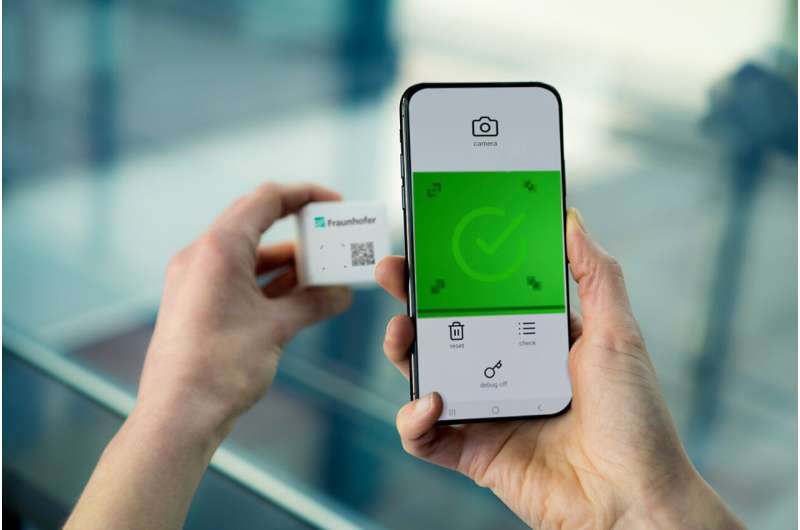This article has been reviewed according to Science X's editorial process and policies. Editors have highlighted the following attributes while ensuring the content's credibility:
fact-checked
trusted source
proofread
Checking for counterfeit medication using a smartphone

When it comes to medication or medical devices sold online, end-users often wonder whether these are real or fake. The SmartID counterfeit-proof barcode system means anyone can use a smartphone to check a product is genuine, provided the manufacturer uses SmartID. It can be authenticated without connecting to a database.
SmartID has been developed by a consortium of Fraunhofer institutes. The result of a three-year project, they will exhibit a demonstration version of their SmartID at the joint Fraunhofer booth (Hall 3, Booth E74) at MEDICA 2023 in Düsseldorf from November 13 to 16, 2023.
The worldwide market for counterfeit medicines is flourishing. About 1 in 10 medicines purchased online is counterfeit, according to a 2020 estimate from the World Health Organization (WHO). Counterfeit medicines involve a wide range of products—from lifestyle medicines such as slimming or hair growth products to essential medicines such as cancer drugs, painkillers, or medication for high blood pressure.
So that end-users can confirm the authenticity of medications and other types of products, the Fraunhofer Institutes for Applied Polymer Research IAP, for Secure Information Technology SIT and for Open Communication Systems FOKUS have developed a new type of labeling system: SmartID.
Surface texture of packaging as a fingerprint
"With SmartID, everyone in the supply chain can verify and authenticate a product that carries a SmartID code directly via a smartphone—offline, i.e., without having to connect to a database," explains Dr. Tobias Jochum, project coordinator based at the Fraunhofer Center for Applied Nanotechnology CAN in Hamburg, a research outpost of Fraunhofer IAP. "We leverage the fact that all packaging has a unique, characteristic surface texture—similar to a human fingerprint—and that standard smartphone cameras are able to capture this surface texture," says Jochum.
The key to the system: Information about the surface texture is digitized and converted into a barcode which is printed onto the packaging. The SmartID app developed as part of the project is then used to check whether the information stored in the barcode matches the data captured from the surface texture. A counterfeit-proof barcode is generated, which can also include other information about the product.
The advantage for manufacturers is that no IT infrastructure needs to be set up, as verification and authentication take place entirely within the SmartID app on the smartphone. No database required. What's more, the system is easy to integrate into commercial printing processes when producing the packaging.
"One major requirement for the SmartID idea is that the barcode and the area needed for comparing the surface textures are as small as possible. As the project evolves, we will optimize the system in terms of the area required and also the sensitivity. Quantum materials will play a key role here. "These make it possible to detect significantly more surface texture features over a smaller area," says Jochum.
Anti-counterfeit barcode for all kinds of products
The research team has worked continuously on the labeling system over the last three years, and it is now attracting attention. "People from a wide range of industries selling top-quality products have already shown an interest in SmartID, including from the fields of interior design, mechanical engineering, the printing industry or even the medical sector, where the system might be used for protective materials such as breathing masks," continues Jochum.
"We are currently still in the project development phase, but we are already negotiating licenses for the SmartID technology," says Jochum happily. They have partnered with Evia Research GmbH, who would like to use SmartID in the fashion industry. "Protection at individual product level based on unique surface textures was very attractive. We also like the idea of offline verification: no database, so we can offer our customers innovative, sustainable products," explains Steffen Tauber from Evia Research GmbH.
"The vast number of inquiries we get shows we must be on the right track. We're really looking forward to some fruitful conversations and to discovering new areas of application for SmartID at MEDICA. Companies can get an immediate impression of our demonstration version there," explains Jochum.





















